OONA and Lori Baldwin’s “Milking the Artist” Provides Crypto Art Some Much Needed Nourishment
I. The Context
We’re certainly an arrogant art movement, aren’t we? We uniformly preach crypto art’s importance. As a new paradigm for artists. As an unprecedented aesthetic movement. As the next big thing. We’re striking fear into the traditional art world, all the Van Gogh and Picasso collectors, because who would ever want a dusty old painting of a sunflower — cracked in places and requiring extensive temperature controls — when you could own an invincible XCOPY? A Beeple? A Fidenza?
Let’s talk about some of our failings. Here’s a good one: We are failing, hard, at actually exalting that which has given us this entire art movement to begin with: the blockchain. The crypto art canon of 2022/2023 rarely even references the blockchain, treating it as little more than a transactional mechanism for the buying and selling of digital files. Think back to the crypto artists of yesteryear. We forget, perhaps, that DADA.art’s artist royalties were a blockchain innovation, sacred and paradigm-shifting, and yet here we are, fighting en masse over their necessity. We forget that NFT culture was pioneered by cryptocurrency faithful, which is why early crypto art, like Rarepepe’s (the Nakamoto card a prime example), Cryptopunks, or the works of early artists like Han, Norman Harman, Trevor Jones, ROBNESS, Matt Kane, Albert, and DJ Scrilla (all represented in MOCA’s Genesis Collection) all overtly reference the blockchain via symbology, nomenclature, and iconography. The point of the movement was the blockchain: its royalties, smart contracts, and permanent transparency.
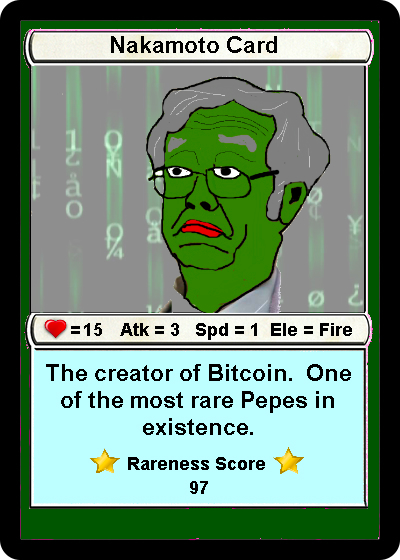

Oh, and here’s maybe the largest failing of all: Where are all the women at? This space is filled with countless talented, innovative female and female-identifying artists, and yet, according to Cryptoart.io, only 2.5 of the 45 highest selling artists (that would be MonicaRizzoli, Grimes [if she counts], and half of Hackatao) outwardly identify as female, the rest either using He/Him pronouns or remaining anonymous. Fewocious, number 9 on the list, is not shy about his transgender identity, and, yes, his story is surely worthy of mention, attention, and celebration, but it’s entirely an outlier. Only ONE of the top 50 highest-selling artworks was created by a woman. Which woman? Paris Hilton. Do with that information what you will. Sure, artists like Cath Simard and Claire Silver and Rhea Myers and Emonee LaRussa and Sasha Stiles and Gisel Florez command our collective admiration, but there’s quite clearly a disconnect between the artists we love and those most financially rewarded. Vincent van Dough’s Art of this Millenium gallery boasts only 16% female artists in its 36-person representation. Less than a fifth of the artwork in MOCA’s own Genesis Collection was created by female artists.
I see a parallel here to 1971, when an essay by Linda Nochlin (later a Professor of Art History at Vassar) appeared in ARTnews magazine, redirecting the art world forever. Her “Why Have There Been No Great Women Artists?” is a lengthy and dense essay, and it inspired large-scale conversation, for the first time, on the absence of women in the artistic canon, both revealing and criticizing the absence of art-world conversation around gender, sexual identity, and femininity. What might have motivated that absence? As Nochlin suggests in the essay, borrowing a phrase from John Stuart Mill, “we tend to accept whatever is as natural.”
Ultimately, we are responsible for our own status quo. Who will invoke Linda Nochlin and attempt to wake up crypto art? Because nothing here is natural, either. Nor, however, is it beyond repair. Nevertheless, while we’ve all been crazily seeking acceptance, making art and writing and building and working on our own stuff, the baby blockchain is asphyxiating on its own umbilical cord. Christie’s and Sotheby’s crypto art auctions barely mention the blockchain, with Christie’s calling crypto artists “the next generation of digital artists” a perverse reduction of the blockchain’s importance. Refik Anadol recently installed a piece at MOMA, Unsupervised, which generated huge buzz, but he only barely mentions the blockchain in its description: “The installation is based on works that are encoded on the blockchain, a distributed digital ledger, which stands as a public record of Anadol’s art.” While the blurb is better than nothing, it does nothing to unpack the blockchain’s crucial part in Anadol’s art and his success. Sound familiar?


All of us are eminently informed by our context. Which is why I’ve written ~700 words of context before even mentioning OONA and Lori Baldwin, the actual centerpieces of this essay. Their work Milking the Artist sits at the center of two storied contexts — feminist performance art and blockchain art — while exuding an entirely shocking style; shocking enough to maybe, just maybe, wake us out of our indolence.
Milking the Artist shows us everything wrong with crypto art by being everything right with it: Audacious, blockchain-inclusive, critical, quintessentially of this moment. In existing at the intersection of its two contexts, Milking the Artist situates itself in a new one, offering a path towards healing for a space which often seems to be — sorry — in desperate need of it.
That the piece involves so much Mother’s Milk is almost too fitting. The nourishment quite literally spilleth over.
II. The Piece
It’s ironic that though Milking the Artist had a serious cultural moment, that moment took place heavily in mainstream publications like TMZ, Paper Magazine, Daily Mail. OONA, actually, was none-too-thrilled with the coverage of Milking the Artist, telling me that it “is so funny that this is a piece about the value of women’s artwork yet in most of the headlines our names are immediately reduced to ‘Two Artists’ or ‘Two Women.’”

None of those pieces (as far as I know) explore the performance’s happenstance origin. Milking the Artist was the product of a chance dance-floor encounter when crypto-native performance artist OONA met Baldwin — a self-proclaimed designer of “performances and experiences intended to call spectators to action by questioning aspects of their immediate surroundings.” — in Berlin, beginning an artistic relationship that debuted with their performance at Art Basel Miami in December.
They performed Milking the Artist twice therein: once at the SCOPE ART gallery, where they had been slated to perform before being disinvited “because [Milking the Artist] wasn’t ‘on brand,’” according to OONA, and then again at Art Basel’s main convention hall. Of that second performance, Baldwin told me “The stakes felt a lot higher, plus the energy was really different. People were very well behaved, very subdued, very like I’m looking at art now, and it was just quiet, dead…But then we found a spot, and it just was like a total rupture in the whole space. Like something happened there.”
So what happened? OONA and Lori Baldwin, the former sporting all black (including her characteristic mask and dark sunglasses. The artist’s true identity remains unknown; during our interview she wore a mask and switched between half-a-dozen accents) and the latter all white — stood alone in an empty corner of the cavernous convention hall.
OONA: on Twitter: “This video now has 605K views. Who is milking who. pic.twitter.com/4rg4rUSHHS / Twitter”
This video now has 605K views. Who is milking who. pic.twitter.com/4rg4rUSHHS
Baldwin begins to shout “May I have your attention!” A small crowd gathers, as crowds are wont to do in such a setting. “We are here with two questions!” Then she pauses. By now, cameras have gathered. They seem to have been lurking nearby, hungry for content. “Why does Art Basel fetishize the female breast?” Baldwin continues.
“And reject it when it’s attached to a living body?” OONA cries. She is wearing shoes shaped like a horse’s cloven hooves. They look incredibly uncomfortable.
“The artist is ready to be milked!” Lori announces, standing with uncommonly straight posture, reminiscent of both dominatrix and futuristic executioner, while OONA undoes her black bodice, revealing a pair of bulging, pale, bulbous breasts underneath (“Are those breasts real?” OONA was asked after the performance. “They’re as real as you want them to be,” she responded.)
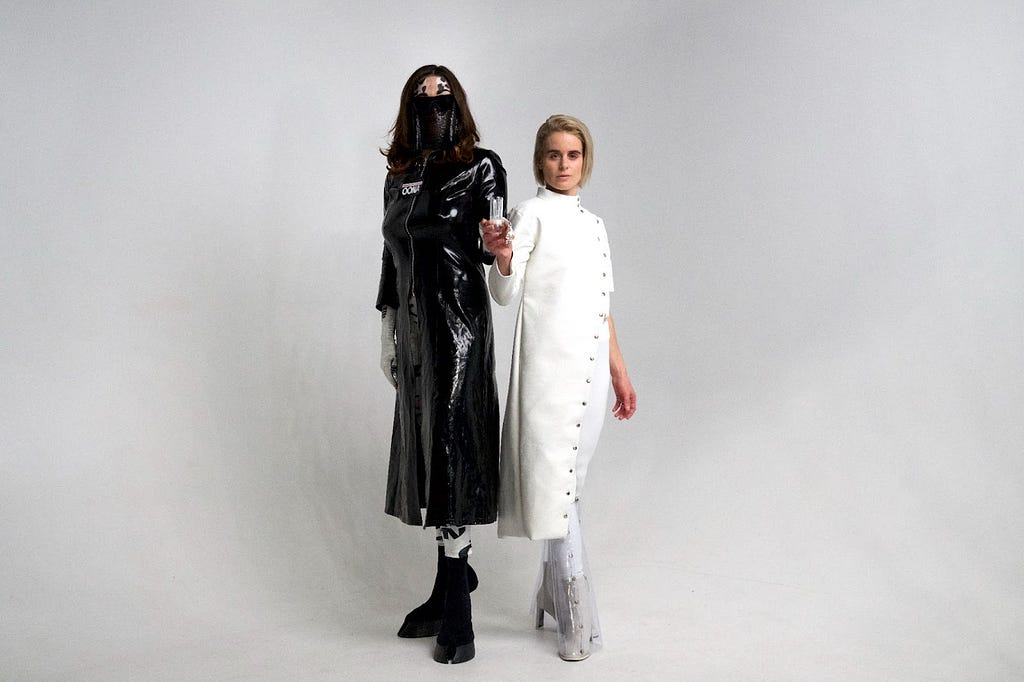
“Do I need to be dead for this art to be valuable?” OONA shouts, bent over from effort, as a stream of thick clotted milk begins to pour out of her breast. Baldwin follows OONA’s nipple around with a glass, catching as much of the milk as possible. It’s all quite ridiculous, what with Lori’s steely-eyed glare and booming voice and expressionless demeanor, the two of them wearing dystopian power-suits, the comedy of the proceedings apparently lost on the stone-faced audience. “Bidding for the artist’s milk starts at 10,000 dollars!” Baldwin yells, kickstarting a bidding war over the contents of the glass. Over two performances, the winning bids were logged at 50 Ether and $200,000 respectively. After the first performance at SCOPE, the audience dissipates. After the second, OONA and Baldwin were forcibly removed.
The winning bidders received not only the physical milk — and receptacle! — but an analogous NFT, featuring milk bubbling over the edge of a glass (a weirdly sexualized image). What an incredible new way of codifying art on the blockchain! Crypto performance art is rare at best (Rhea Myers tokenizing pieces of her soul way back in 2017 is the only example that comes to mind), and to my knowledge, no artwork has yet sought to marry the ephemerality of physical performance art with the eternal blockchain, an inherent irony that allows theoretical ownership (or the feeling of ownership) of a performance art piece. The fact that two lesser-known artists — OONA has fewer than 2200 followers on Twitter while Lori Baldwin was indoctrinated into crypto art only upon meeting OONA in the Summer of 2022 — can introduce an almost entirely-new style of blockchain artistry should itself say a lot about the way this space has developed tunnel vision over what can constitute crypto art.

But what if I told you that the performance was just the start? To quote OONA “At most art fairs, bare boobs only exist in paintings — framed like dead objects. Here the breasts are audacious because they are attached to a living consenting body. [But] nudity is the gateway drug to the deeper layers of this piece. Sure, the performance panders to the general obsession with objectifying women, but it only stops there if you want it to.”
Well, we certainly don’t want that, do we?
III. The Implication: Feminist Performance Art
You almost never see artistry appear in mainstream reporting unless there’s an astronomical sales price attached. Or after some significant scandal. Interest in Milking the Artist thus felt unique. More like the famous Art Basel banana in 2019. But this piece is much better. Bolder, slicker, more shocking. The only reason the banana gained fame was because of the absurdity it revealed about the state of contemporary art. Milking the Artist had its moment, meanwhile, because it was striking and taboo. But it was calculated as such, designed to provoke.
“Shock is access,” Baldwin told me. “It gives people an entry point, and if you can catch the attention of someone who would not normally think ‘Oh, I’m interested in performance art’… maybe that opens the door for conversation about things that they wouldn’t normally be interested in, or have access to, or even think about.”
There’s a long history of this strategy being used to elicit change in the established artist institution. Two examples the artists pointed to specifically are VALIE EXPORT’s Touch Cinema (1968) and Do Women Have to be Naked to Get Into the Met Museum (1989) by the Guerilla Girls. Milking the Artist is a distilled combination of the two, marrying the personal nature of Ms. Export’s work with the bombast of the Guerilla Girls’ famous installation.

Perhaps “Ad Campaign” is a better way to describe Do Women Have to be Naked to Get Into the Met Museum. The Tate Modern Museum described the piece as such:
“Since their inception in 1984 the Guerrilla Girls have been working to expose sexual and racial discrimination in the art world…They formed in response to the International Survey of Painting and Sculpture held in 1984 at the Museum of Modern Art, New York. The exhibition included the work of 169 artists, less than 10% of whom were women…In 1985 the Guerrilla Girls began a poster campaign that targeted museums, dealers, curators, critics and artists who they felt were actively responsible for, or complicit in, the exclusion of women and non-white artists from mainstream exhibitions and publications.”
On their website, OONA and Lori Baldwin ask a pertinent and related question: “Why is it that even though crypto art is meant to be a digital renaissance, we are repeating the worst of what the art world already offers: undervaluing women & non-binary artists’ work, concentrating attention, contriving popularity and inflating floor prices?”
That faux-progressivism is firmly in OONA and Baldwin’s crosshairs. Crypto art seems more interested in appearing progressive than actually assimilating its purported values. Similarly, the 1960’s and 1970’s saw an enormous wave of social unrest and change throughout the United States, but we can look back at these groundswells — be it the Civil Rights Movement or the Stonewall Riots — and see that the cultural progress fought for and supposedly achieved was never actually internalized by the establishment itself. We remain warring 50 years later for the rights championed by Dr. King, Marsha P. Johnson, Sylvia Rivera, Malcolm X and countless others. The Guerilla Girls were more than happy to burst onto the 80’s art scene and point out the hypocrisy of every hyper-white, hyper-male art world institution claiming to be progressive, just as OONA and Baldwin are doing here.
But there’s a distance in the Guerilla Girls’ work. The artists were anonymous, after all, appearing in Gorilla masks when they appeared at all. The actual artwork of Do Women Have to be Naked to Get Into the Met Museum was plastered on a series of billboards and posters distributed throughout New York City. People needed to stumble upon the art if they wanted to see it.
Conversely, the Austrian-born artist VALIE EXPORT spent three years bringing her Touch Cinema directly to the public in ten European cities. As per the Kemper Art Museum “For these performances the artist built a tiny “movie theater” around her naked chest. She invited people to “visit the cinema” by touching her body inside the curtained box…Challenging the public to engage with a real woman instead of with images on a screen.”
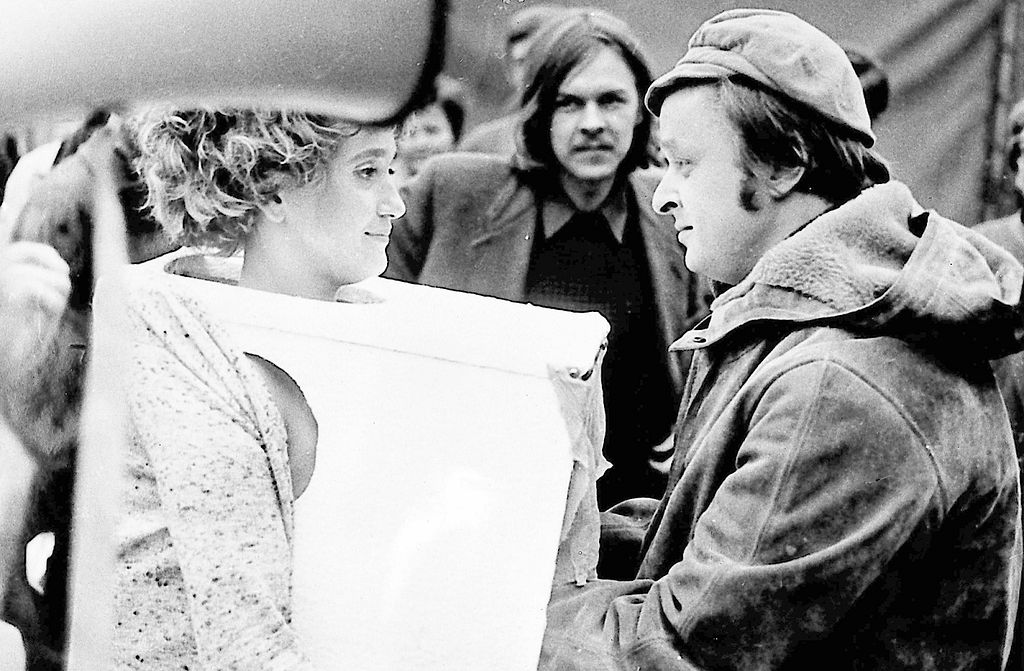
OONA became quite animated talking about EXPORT’s piece, saying “It’s taking something that’s already in the public domain — breasts — already widely distributed and widely available, but putting people in an immediate relationship to it, and offering people an opportunity to question it.” It’s easy to see the influence of Touch Cinema on Milking the Artist. Not just because of the linked subject matter, but because of the hyper-personal nature of being there in that room with Baldwin and OONA (either personally or via video), seeing the breasts yourself, seeing the milk yourself, feeling the visceral response.
Milking the Artist is spiritual successor to both pieces, stitching Do Women Have to be Naked to Get into the Met Museum’s take-no-prisoners frankness to Touch Cinema’s intimacy. And so we watch the video, we listen to OONA and Baldwin talk about this work, and with renewed clarity we realize just how many male photographers like Guido Disalle are making their living on objectified evocations of the female body. Or how many female bodies in the crypto art zeitgeist, like NudeYogaGirl, are idealized to the point of parody (Not a knock on anyone’s art, just spitting facts). Or that OONA and Baldwin didn’t receive much noteworthiness at all until they were seen achieving a six-figure sale.
So now we don’t just see breasts, we begin to notice breasts, and who they’re connected to, and how they’re portrayed, and to what end (Breasts being a metaphor. Actually, synecdoche is more like it).
IV. The Implication: Blockchain
Now, what if I told you that much of Milking the Artist was engineered. Not the performance of course — that actually happened — but the bids, the purchases, the transactions themselves; they occurred, but they were rotten, fake, contrived, and anyone at any time could have seen as much if they had the interest and knowhow to do so. OONA and Lori Baldwin used the in-person performance of Milking the Artist to identify the hypocritical progressiveness of our little slice of the art world. But a second part to the piece reveals our arrogance in a whole new way. It’s not, as the artists reveal to us, that the entire crypto art sphere is fraudulent, artificial, or planted. It’s that it could be. And most of us would have no idea.
So OONA and Lori Baldwin seek to educate us.
OONA: on Twitter: “remember when OONA & @iamloribaldwin made 50ETH in >3 minsselling artist’s breast milk? NowYou’rePayingAttention.Eth Here’s How You Can Do The Same: #MilkingTheArtist* #ArtistsAreInfluencers*** aren’t u already? ** RT this & make us laugh /think & you’ll get paid pic.twitter.com/9IBmxZDKws / Twitter”
remember when OONA & @iamloribaldwin made 50ETH in >3 minsselling artist’s breast milk? NowYou’rePayingAttention.Eth Here’s How You Can Do The Same: #MilkingTheArtist* #ArtistsAreInfluencers*** aren’t u already? ** RT this & make us laugh /think & you’ll get paid pic.twitter.com/9IBmxZDKws
Go check out OONA’s and Baldwin’s Twitter or Instagram pages to see copious references to “Wallet-washing” or “wash trading,” a practice in which, according to CNBC “a trader buys and sells the same financial asset multiple times in order to generate fake volume and make it appear as if there is a high demand for the asset. This artificially inflated demand can mislead other traders into investing real money into the asset.”
The question is not whether this happens in crypto art, it’s how often?
Those 50 ETH and $200K bids on Milking the Artist NFTs? Strangers in the audience really did make them. That much is true! But a bid and a sale ain’t the same thing. If we push past all the marketing and examine the blockchain transactions themselves, we’d see that while, yes, money was transferred into OONA’s wallet, it was OONA’s own money being exchanged for OONA’s own artwork, between wallets OONA herself owns.
And thus, The Wallet Wash (absolutely watch the video in the tweet above if you haven’t).
As OONA told me “This is the first piece in my practice where I’m actually using the blockchain as its own medium as opposed to using the blockchain to just transcribe or have a record of what I did in another medium off the chain…Those four transactions, where you can see that OONA bought Now That You’re Paying Attention, OONA transferred Now That You’re Paying Attention to this wallet address, this wallet address then pays OONA, those four blockchain transactions…are the performance art. OONA using the public ledger as a place to question value in relationship to women’s artwork and the integrity of blockchain transactions” (or lack thereof, I might add).
We can see in the following blockchain transactions what a Wallet Wash of this kind actually looks like:
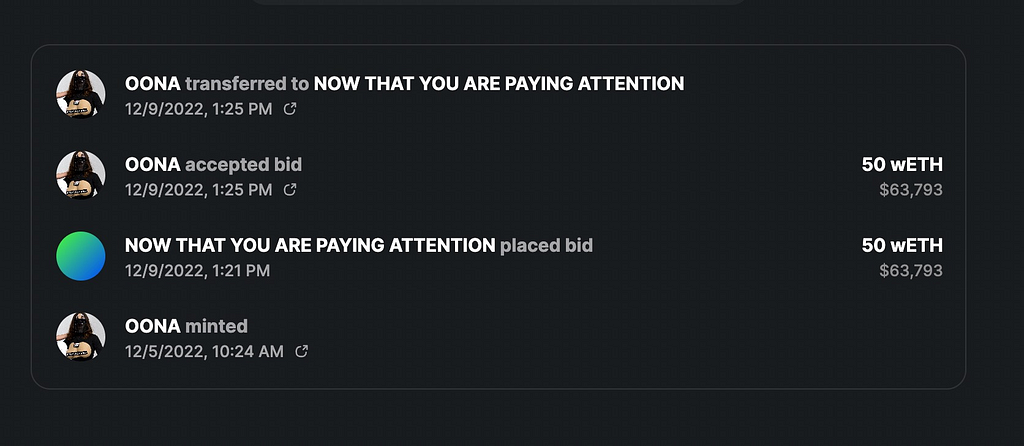
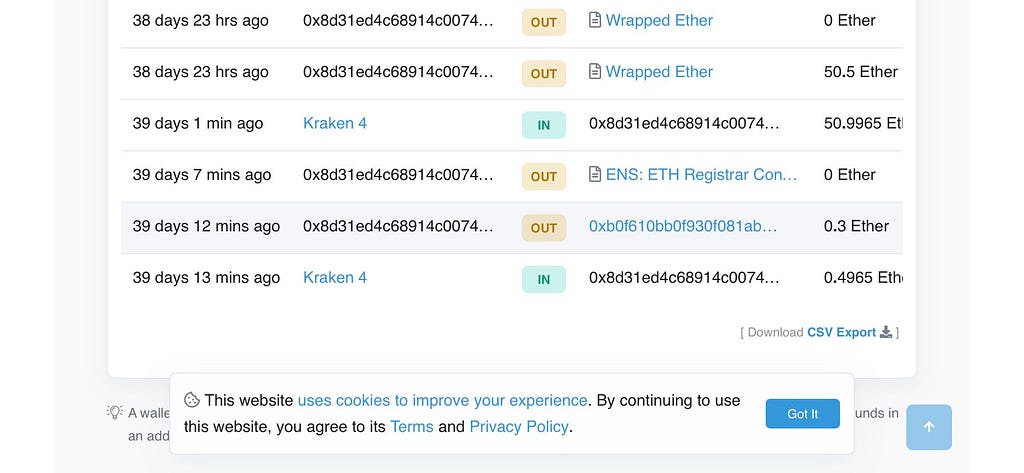
Clearly, you’d have to know what you’re looking for. And you’d have to have a reason for suspicion in the first place. Without OONA and Lori Baldwin very clearly and deliberately pointing out their wash, without them turning the reveal itself into a pointed video art piece in its own right, we’d likely never have any idea. OONA and Baldwin might have skyrocketed to crypto art superstardom (they might anyways) on the back of their massive financial success, and it could have all been a farce.
And what we learn is to maybe stop believing that every sale around us is legitimate. Even when transactions are transparent — the very thing that’s meant to make the backchannel art deals of the traditional art world impossible — deceit abounds. Vigilance in this space is an oft-underrated trait.
OONA told me “There’s a thread of transparency in Milking the Artist that has roots in crypto art, specifically Matt Kane’s Meules after Claude Monet.”
Do you know that story?
Matt Kane was one of the first crypto artists to attain a Sotheby’s auction, whereafter he received a seismic bid on his artwork Meules After Claude Monet — a study blending Kane’s inimitable style with a Monet aesthetic — to the tune of $214,200. Even now, we can see Sotheby’s website claiming this number as the sale price. But when institutions lie, the blockchain tells the truth. And what does the blockchain tell us? No such amount was ever transferred to Mr. Kane in exchange for this artwork, which still sits in his personal MattKaneCollection. This entire debacle was subsequently immortalized in Kane’s Gazers collection, as one of 12 “Origin Moon” traits, this one aptly titled No Sale. Of course, Sotheby’s is no worse for wear. Even now, crypto artists the space over see the possibility of having their art auctioned there as a momentous mark of success.

Forbes recently published an article titled “Up To Four-fifths Of Crypto Trading Could Be Phony, New Research Shows” which certainly seems extreme, but when we look at the space around us — the dearth of new collectors, the general social mistrust of NFTs and blockchain — doesn’t it seem strange that the same handful of artists still regularly manage five/six figures sales? Strange is all. Strange enough to warrant our attention. Because perhaps we weren’t paying attention.
But I bet we’re paying attention now.
V. The Conclusion
Paying attention to tits and the blockchain. Sounds like the punchline of a joke. Sounds like the life SBF was living in his paradisiacal penthouse in the Bahamas.
But, of course, paradise is always better in theory than in reality.
The issue at the core of crypto art, our own artistic paradise, is that we’re arrogant. We feel we know so much, have experienced so much, can predict so much. And that leaves us lazy, blind, willfully ignorant. It’s not that we don’t see femininity, but we don’t think about it in context: Whose femininity is it, why are we seeing it, and with what purpose, and who is benefitting? The blockchain follows the same principle. We accept that it’s there, we accept what it does, but we don’t think in depth about how we can use it, how it’s being used, what it means, and what’s being done to corrupt it.
The greatest trick the devil ever pulled was convincing the world he didn’t exist. Right? Blockchain isn’t the devil, but crypto art seems to have forgotten that this space is as much about crypto as it is about art.
Obviously, no artist has a mandate to acknowledge the blockchain, just as no female-identifying artist has ever had a mandate to produce feminist artwork. I’ll never be one to tell an artist they should or should not, can or cannot, must or must not do this or that thing. But let’s not be naive: Aesthetics are fleeting, and tastes will change. Today’s important artists will be forgotten, replaced by others who better capture some future zeitgeist. Our communities will disperse. Our institutions will go bankrupt, consolidate, break apart, cede to disruptors. But conversations about gender and sexuality remained when many artists of the time faded.
Judy Chicago, Mirami Schapiro, the Guerilla Girls, and many other feminist artists ensured that these conversations were held, that this issue wouldn’t just get swept away, outta sight outta mind. I want to believe that the blockchain will always remain, but will it? Maybe not if we keep treating it as merely a transactional mechanism and not as an artistic tool in its own right, something to be nurtured and protected because, boy oh boy, there are powerful forces attempting to exploit it for their own ends.
I titled this piece Breastfeeding the Blockchain because pieces like Milking the Artist, in forcing us to pay attention to the blockchain, do it a monumental service, just as in forcing us to pay attention to femininity in our cultural milieu they raise vital awareness about female artistry everywhere. Just experiencing this artwork makes one more aware, and awareness is a currency we sorely need more of.
It is rare in this space to find feminist crypto art, performative crypto art, or crypto art exposés; all of Milking the Artist is new and nourishing. The blockchain needs this. We need this. We need more art that cinches our eyes open a la Alex A Clockwork Orange. Painful, yes, but ultimately restorative.
100 years ago, the Modernist art movement solidified itself as a massively important cultural touchstone, with the self-proclaimed urge to shock the bourgeoisie out of their complacency. We’ve been desperately in need of something, or someone, to shock us out of ours. Maybe OONA and Lori Baldwin’s Milking the Artist will induce a wave of new modernism. Crypto art modernism. Sure, like everything else in crypto, it’ll probably be over in a few months. A slap in the face heals. A bucket of cold water dries. I don’t know if we’ll be wide awake thereafter, but if we are, OONA and Baldwin will be largely to blame.
Or to thank.